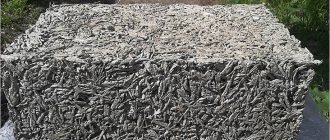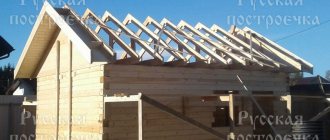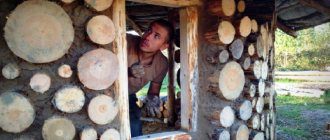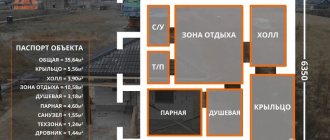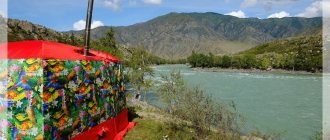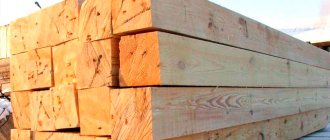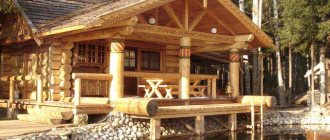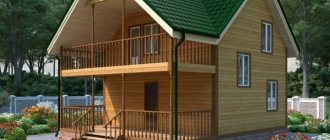You can build a bathhouse from different materials: wood, brick, aerated concrete, expanded clay concrete, etc. Of course, the most popular option is wood. This material helps to create a cozy atmosphere and feel oneness with nature, but in order for the building to be reliable, you need to choose the right type of wood.
For the construction of baths, they mainly use tree species common in Russia, for example, aspen. Aspen can be found in every corner of our country. Our ancestors also preferred to build a bathhouse from this material. But is aspen so good for a bath? Reviews about this material vary widely, so let's find out.
Choosing what is best for a bath...
To understand what you are dealing with, it is correct to compare different options. We have already written about the popular dilemma of choosing between linden and aspen, now we will consider two other pairs that are compared a little less often.
Pine or aspen
Be prepared for the fact that there will be no clear answer. Because first of all, you need to look at the quality of the same pine and the same aspen - there are regions where one is better than the other.
By the way! According to tradition, pine was usually used to build a house, and aspen - a bathhouse.
But it is always difficult to obtain good, functional aspen without rot inside ; there is a lot of defects at the selection stage. Here, by the way, is a big piece of advice for the owner of a future bathhouse - check each log yourself when purchasing - so that the core is intact, it suffers primarily from rot.
You need logs - 15-20 centimeters or more, so be careful - trees of this thickness most often have a problematic core.
ON A NOTE! Rotting aspen is accompanied by the smell of vanilla - if you smell it, put the log aside from healthy ones.
In this regard, pine is less susceptible to rot and pests, but it swells greatly from water. And resin is a problem in a steam room.
pure pine without interior decoration of a steam room , so there is no need to say which is better: a bathhouse made of aspen or pine - the choice lies between a pine bathhouse with aspen clapboard inside the steam room or an aspen bathhouse without clapboard trim.
If you prefer a log house in its pure form , if there is no need for additional insulation, then make it from aspen - everything will be fine, it will only become harder later, water “hardens” it.
If there are problems with a good aspen, if you know that a poplar in instead of it (they are relatives, the wood is very similar, but its quality is different, aspen grows in a swamp, hence its resistance to water, poplar does not have it), then take a good construction pine , build a log house from it, and protect yourself from resin with a clapboard made of aspen or linden (or other hardwood). See more information about pine here.
Alder or aspen
But here it’s more interesting - both species are deciduous, both are suitable for finishing a pair of rooms. As for a log house, aspen is definitely suitable for its construction, and alder is considered a good interior(!) material - its characteristics are similar to linden.
Therefore, we would risk recommending the following: focus here on the quality of the material. Since there is little good aspen, and specifically in your region there is good alder, you can build from it, but on condition that the lower crowns are made of oak or larch (contact with water and soil for alder leads to rotting).
BY THE WAY! The rule of the lower crowns, that is, making them from more durable and rot-resistant species, can be applied to aspen - only you will do it better.
In addition, the areas under the windows - this is a reason to take care of additional protection of these areas or to abandon windows as much as possible, leaving only the necessary ones.
In general, in the question of what is better for a bathhouse: alder or aspen, we place our bet on aspen, relying in this, as you already understand, on tradition.
Briefly about the main thing
It is quite difficult to determine which is better for a bath: linden or aspen. It is not easy to choose a material, especially if you need to take into account the properties of wood and its disadvantages. Aspen is excellent as a basis for construction, second only to linden in aesthetic qualities. Therefore, it is best to finish the interior steam room from linden. When choosing, it is important to take into account the age and location of the tree being cut; the quality of the material may depend on this. It is important that the aspen trunk is not subject to internal rot, which can spread to the entire finished building.
Ratings 0
Service life of an aspen bath
Of course, no one can predict the service life of an aspen bathhouse specifically in your case. Wood is different everywhere, and aspen is capricious - it is advisable to cut it down in the spring, and select the trunks so that there is no rot even in the initial stage.
During operation , you can also extend or shorten the service life - it depends on whether you have provided all the conditions for drying or not.
From the outside, the structure is exposed to atmospheric precipitation, so it is advisable to treat the log house with antiseptics and water-repellent impregnations - this will also have a positive effect on its service life. We wrote about processing logs for log houses here, and about processing timber here.
And you shouldn’t believe those who say that antiseptics on the outside will affect the atmosphere inside - even industrial processing does not penetrate the log deeply, and independent impregnation goes no more than 3-5 mm . Therefore, it requires renewal every few years.
Inside, as already mentioned, there is thoughtful ventilation , plus, possibly, water-repellent, harmless impregnation with oil or oil wax. This is essential for the steam room and washing room; in other rooms you can varnish, paint - whatever you like.
Well, if you need at least some numbers, we found these on one of the forums: the builders themselves give the average log bathhouse made of aspen 20 years , but if the wood is selected well and the conditions are provided, then the bathhouse can last for half a century .
Characteristics and properties of linden, its differences from aspen
Linden board is a popular finishing material due to its large selection in stores and affordable price. However, this type of wood also has other successful characteristics:
- softness;
- nice smell;
- low thermal conductivity.
It differs from aspen in a warmer, richer shade. In addition, linden contains many beneficial essential oils. However, it is more often affected by pests and is more susceptible to rotting and destruction. Unfortunately, linden also darkens, and even faster than aspen.
Chopped sauna
Since both a round log and timber ( or rectangular in cross-section) can be used as a building material for a chopped bathhouse, we decided to talk about both separately.
From timber
You need to understand: a log with a diameter of 15 and a beam with a side of 15 cm are different source materials in thickness, because to make a beam with a side of 15 cm you need a log a little more than 20 cm in diameter. Remember the Pythagorean theorem and calculate how thick a tree is needed for a 20 cm beam.
What is this for? Moreover, aspen timber will be more expensive than logs - because its production requires older, thicker trunks, and they are most often rotten inside. Yes, and you still need to look for straight aspen. As a result, we get material that required more careful selection than a log of the same diameter.
is no different from a log house in terms of choosing the material and caring for it The only difference is the greater likelihood of core rot, which must be discarded, but otherwise everything is the same. Protect from moisture, dry and it will last a long time.
Here is another video in which you can see how unevenly the aspen frame has shrunk:
Log house: pros and cons, reviews
If we compare the pros and cons of a log bathhouse made of aspen, the reader himself will be able to come to the conclusion whether he wants to build such a bathhouse for himself or not.
But it’s probably worth starting with the fact that it is not true that aspen used to be used for firewood, but is now sold at exorbitant prices for bathhouses. The aspen tree is full of parts unsuitable for construction, which are used for firewood and matches, and this can be a part, or maybe the whole trunk.
The part suitable for construction is usually small and located high above the ground . The yield of building wood is usually small, and there is still drying ahead, during which the tree may warp, so aspen that is not rotten or warped is a rare and good material, and it can also be expensive.
And if we talk about the advantages and disadvantages, then only high-quality material.
Let's call the disadvantage of an aspen bathhouse that it is less resistant than other species to the action of fungi that cause rotting. But coating with antiseptics and other impregnations solves this problem.
The second disadvantage is that wood for construction must undergo a long drying period or it is accelerated drying using modern technologies. Otherwise, the under-dried wood will greatly change its dimensions during drying.
IMPORTANT! However, they try to cut and process aspen while it is not yet dry, because the ease of processing depends on the presence of juices inside. It is known that the drying wood of this tree becomes more hard and dulls the instrument.
The advantage of aspen baths is that hardwood is used, which does not emit resin. It is perfect for a couple's room.
Aspen is a little better than linden in terms of technical characteristics and a little cheaper than linden. Among deciduous trees, ash has excellent characteristics, but we take the most common options from the species of this category.
Reviews about aspen baths, as expected, are ambiguous; there are both ardent supporters and opponents of this wood, based on their own experience of interacting with it.
What can we say? That a lot depends on the handling of this wood. The advice given above was not given out of the blue - you can rot a bathhouse in three years before major repairs. And the original quality also affects a lot - if the core is rotten, then you can’t expect anything good.
On the other hand, there are many people who have observed the durability of an aspen bathhouse in their homes or their neighbors, relatives, and acquaintances. But then we had a question: what were these long-lasting baths like? To put it bluntly, this is a completely different system, it has a lot of ventilation and a layer of soot on the surface acts as an antiseptic, so you can’t rely on such a bathhouse today. Wood harvesting also matters - if everything is according to the rules, then you can count on durability.
There are many nuances, and reviews depend on them. If you decide to build from aspen, be sure to protect and ventilate it.
A short excursion into the world of botany
Aspen is often called trembling poplar, and indeed, it has a lot in common with poplar. As a rule, this is a tall, straight-trunked tree with abundant foliage. The dense foliage looks very beautiful in the fall, when it takes on a bright reddish hue. Apparently, it was aspen groves that once inspired Alexander Pushkin during his Boldino autumn.
In the modern world, this tree is a very popular species among municipal green building workers. On the one hand, it grows quickly, on the other hand, it greatly decorates and enlivens the city landscape in the autumn. It is not for nothing that breeders have worked hard and developed various forms of this tree, including pyramidal and dwarf ones, for the needs of urban farming.
The aspen tree has a very developed deep root system, which allows aspen trees to withstand intense continuous forest fires. The distribution area is very wide and starts from the border of the tundra in the north and ends in the forest-steppe. Even in the steppe zone, aspen splinters are a common occurrence. The most characteristic feature of this tree is the slight characteristic noise that the foliage makes at the slightest breath of wind. The reason lies in the wide leaf blade and long thin stalk. That’s why the aspen leaf trembles and makes noise in the wind.
Finishing with aspen lining
A good alternative to building an aspen log house is finishing it with clapboards made from this type of wood. In this case, you can choose more resistant wood for the log house or even build a bathhouse from less traditional materials - frame, brick, foam blocks.
Aspen sauna lining is intended primarily for steam rooms . For the rest, you can use any other breed. Which, by the way, is very convenient, because we haven’t heard about logs made of different types of wood for rooms, and there are no such problems with finishing - you can choose any characteristics to suit your taste.
So what we're saying is that outside of the steam room, you don't need to clap the walls with aspen unless it's part of the design plan. After all, everything has its advantages and disadvantages
Aspen lining: pros and cons
Light-colored, fine-fiber lining, its hardness varies significantly depending on the degree of shrinkage - from soft, like linden, to such that the tool bounces off. However, the latter is more about logs, and thin lining in any condition can be cut.
The main disadvantage of aspen lining for a bathhouse is that it darkens over time. This happens with all wood that is regularly moistened, but in aspen it is more pronounced. If you compare it with linden, for example.
Aspen darkens from water
But this is a decorative flaw inherent in this particular wood. By the way, you can always get rid of it using chlorine bleach - special for baths or regular “Whiteness”, which is a solution of sodium hypochlorite.
with water-repellent impregnations based on linseed oil or beeswax can protect against darkening It is possible to use other oils, but not sunflower oil, of course. We wrote about wood bleaching here. We also recommend that you study the material on lining processing or watch the video version below.
The advantages of aspen lining in a steam room are that it does not emit resin, is available at the lowest price among other species, rooms decorated with it look more spacious because it is light (at least at first
